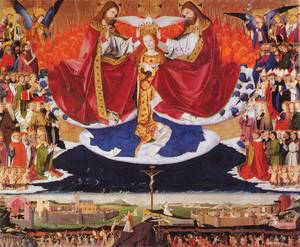
 T THE MOMENT, I find that I am in love with the painter Enguerrand Quarton (c. 1410 – c. 1466). He was French and painted in a style that is composed of a bizarre combination of French, Netherlandish, and Byzantine influences. Two of his surviving masterpieces are The Pietà of Villeneuve-lès-Avignon (figure 1) and The Coronation of the Virgin (figure 2).
T THE MOMENT, I find that I am in love with the painter Enguerrand Quarton (c. 1410 – c. 1466). He was French and painted in a style that is composed of a bizarre combination of French, Netherlandish, and Byzantine influences. Two of his surviving masterpieces are The Pietà of Villeneuve-lès-Avignon (figure 1) and The Coronation of the Virgin (figure 2).
Click on the images to see them in greater detail.

 Just look at the exquisite quality of line in The Pietà of Villeneuve-lès-Avignon. I can’t get over how every element is designed to have a beautiful silhouette; even the fingers of St. John are fascinating. The underlying structure of this painting consists of a series of lines that slope downwards from left to right: Christ’s arm, Christ’s legs, Mary’s head, Mary Magdalene’s body. It is as if every line is a wave grief lapping at the foot of the cross. Like a Byzantine icon, the background is gold. Like a Flemish masterpiece, the figures are rendered with startling detail.
Just look at the exquisite quality of line in The Pietà of Villeneuve-lès-Avignon. I can’t get over how every element is designed to have a beautiful silhouette; even the fingers of St. John are fascinating. The underlying structure of this painting consists of a series of lines that slope downwards from left to right: Christ’s arm, Christ’s legs, Mary’s head, Mary Magdalene’s body. It is as if every line is a wave grief lapping at the foot of the cross. Like a Byzantine icon, the background is gold. Like a Flemish masterpiece, the figures are rendered with startling detail.
 Not only does Quarton have an captivating sense of rhythm and beauty, his color is also stunning. Look at his painting, The Coronation of the Virgin. The earth below contains the cities of Rome and Jerusalem. At the very bottom are souls in Purgatory and Hell. The Holy Trinity place a crown on Mary’s head as choirs of angels and saints look on. Although Mary is depicted in a somewhat stylized manner, the effect of her presence is overpowering due to the flaming seraphim and cherubim that surround her. She who humbled herself hath been exalted.
Not only does Quarton have an captivating sense of rhythm and beauty, his color is also stunning. Look at his painting, The Coronation of the Virgin. The earth below contains the cities of Rome and Jerusalem. At the very bottom are souls in Purgatory and Hell. The Holy Trinity place a crown on Mary’s head as choirs of angels and saints look on. Although Mary is depicted in a somewhat stylized manner, the effect of her presence is overpowering due to the flaming seraphim and cherubim that surround her. She who humbled herself hath been exalted.

